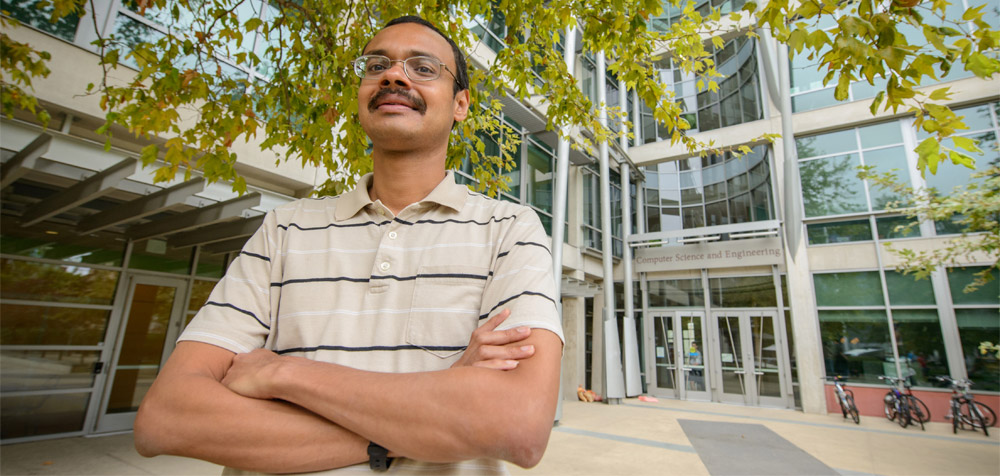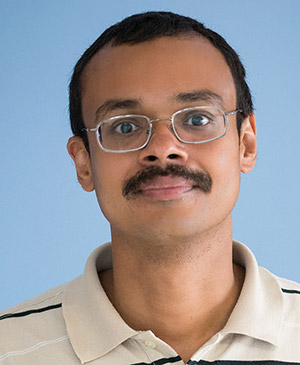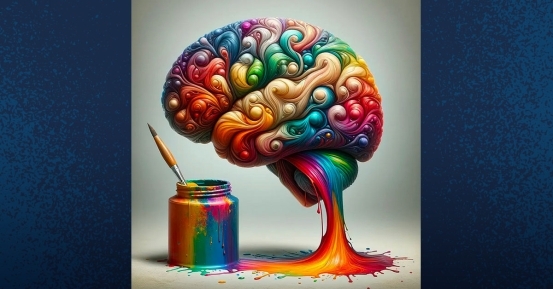
New Hire in Computer Graphics Has Ambitious Agenda at UC San Diego
Published Date
By:
- Doug Ramsey
Share This:
Article Content

Prof. Ravi Ramamoorthi in front of CSE building
“Much of my research lies at the interface of computer graphics and computer vision,” says Ravi Ramamoorthi, the senior faculty hire this year for the Computer Science and Engineering department at the University of California, San Diego. “I have published and been active in both of these communities, so I have tried to build bridges between them.”
Effective July 1, Ramamoorthi began building new bridges. Together with fellow CSE professors David Kriegman (in computer vision) and Henrik Wann Jensen (in computer graphics), Ramamoorthi says he hopes to help build “visual computing at UC San Diego – graphics and vision – into the best group in the world.”

Ramamoorthi joined the Computer Science and Engineering faculty at UC San Diego on July 1, 2014.
Building bridges will also be helpful as Kriegman, Jensen and Ramamoorthi reach out to other groups on campus with substantial strengths of their own in the field, notably Mohan Trivedi and Nuno Vasconcelos in the Electrical and Computer Engineering department, as well as Zhaowen Tu in Cognitive Science (with a faculty affiliation in CSE), and Calit2’s Qualcomm Institute.
CSE department chair Rajesh Gupta says Ramamoorthi arrived at an opportune time. “We are actively looking to hire at all levels: junior and senior faculty, postdocs and graduate students,” says Gupta. “We brought Professor Ramamoorthi on board because he is a world-renowned expert in the field of computer graphics, and with CSE in a fast growth period, he can help propel UC San Diego to the top in both size and quality of research product.”
The department expects to add at least two more faculty members in graphics and vision, and hopefully more. Also ahead, the group hopes to build a joint research center and to go after large-scale NSF and industry support, while also beefing up the range of courses available to students. “We want to have a full teaching program in graphics and vision to expose students to the full range of the field,” says Ramamoorthi.
For his own part, Ramamoorthi will begin teaching a graduate course this winter at the intersection of graphics, vision and photography. Then next spring, he will launch a new Advanced Graphics course for upper-division undergraduates. He also intends to teach an online course for a broad audience later this year. His prior online course, “Foundations of Computer Graphics”, last ran on the EdX network in Fall 2013, and is also available on the UC Berkeley website.
When Ramamoorthi joined the Columbia University faculty in 2002, Columbia was just starting to build its Vision and Graphics Center. “We went from zero papers in SIGGRAPH four years earlier to having ten papers four years later – more than any other group that year,” he recalls. Then in January 2009, a young family in tow, Ramamoorthi moved back to California. He joined UC Berkeley to help rebuild their program in computer graphics. “There wasn’t that much activity in graphics at Berkeley the previous few years, but we built that into what you can argue is the best graphics group in the country,” he notes. “Building these groups has been an exciting part of my career so far, and I hope to do an even better job at UCSD.”
Asked why there is growing interest in visual computing as a field, Ramamoorthi notes that more than 90 percent of the sensory information we receive is through our eyes. “Computer graphics and computer vision are becoming fundamental and intrinsic to our everyday lives,” he argues. “We’ve already seen the impact on movies and gaming, but increasingly you’ll see it on your mobile phone, which now has a graphics chip as powerful as you have in your desktop computer.”
Ramamoorthi did his undergraduate work at Caltech, where he completed a B.S. and dual M.S. degrees in computer science and physics in 1998. He then earned his Ph.D. in computer science at Stanford University in 2002 with a dissertation on spherical harmonic lighting (now widely used in videogames and movies – including for the production of “Avatar” and various animated films from Pixar, where he was a consultant for three years). While working in Stanford’s Computer Graphics Laboratory, he established a firm mathematical framework to describe reflection – leading to a deeper theoretical understanding of light transport and its impact on the visual appearance of objects.
The graphics guru has collaborated with UC San Diego faculty and students for more than a decade. He and Henrik Jensen worked in the same lab at Stanford (under Pat Hanrahan) and completed their Ph.D./postdoc the same year (2002). Ramamoorthi has co-authored papers with Jensen and former CSE Prof. Serge Belongie (who moved in January to Cornell NYC Tech), and with CSE alumnus Sameer Agarwal (Ph.D. ’06), among others. For two years, his postdoctoral researcher at Berkeley was Manmohan Chandraker, a CSE alumnus (Ph.D. ’09), whose advisor was CSE Prof. David Kriegman. Earlier, while at Columbia, Ramamoorthi hired a postdoc, Craig Donner, who had been a UCSD graduate student (Ph.D. ’06) and then a postdoc, both under CSE’s Jensen.
In 2008 Ramamoorthi received a Presidential Early Career Award for Scientists and Engineers from President George W. Bush for his work on physics-based computer vision. A year earlier ACM SIGGRAPH gave him its Significant New Researcher Award, citing his “seminal contributions to the visual appearance of objects.” In its news release about the award, ACM lauded the then-Columbia University professor for developing “mathematical and computational models that have led to a deeper understanding of visual representation by digitally recreating or rendering complex natural appearances.” Ramamoorthi was also one of only two computer scientists to receive a Young Investigator Award from the Office of Naval Research (ONR) in 2007.
Share This:
You May Also Like
Stay in the Know
Keep up with all the latest from UC San Diego. Subscribe to the newsletter today.


